Updated 2021 with a revised selection of current bars.
Table of Contents
Intro
This is for olympic weightlifting bars (often called WL bars for short) that are best for doing the clean and the snatch. For powerlifting bars for deadlifts, squats and bench press, see the powerlifting bars comparison. Muscle & Fitness also has a good basic article on the difference between powerlifting and weightlifting, with a bit of history.
With the rise of olympic lifting in Crossfit, and other lifters incorporating olympic lifts into their existing routines, more and more people are in search of bars that are more appropriate for olympic lifting than the traditional power bars that have been marketed towards bodybuilders, casual lifters, and powerlifters.
Olympic weightlifting bars are used frequently at olympic lifting gyms, Crossfit boxes, the Olympic Games or anywhere that lifters may be doing olympic lifts. They are made to be springy at high loads to facilitate explosiveness, prevent a high shock load for the lifter, and absorb the shock of being dropped.
It isn’t necessary to get a $500-1000 bar just to have a good tool for olympic lifts. Bars in that range are typically IWF certified bars, which carries a huge bump in the price tag. Plus, those bars are normally not appropriate for anything but practicing a few heavy singles, because the knurling is meant to really grab onto your palms to help you get the barbell up for that one heavy lift that really counts. For learning the lifts and doing regular workouts, you’re better off with a medium to soft knurling that won’t eat up your hands.
The knurling further down the bar should extend to the end of the shaft to accommodate tall users with the maximum width snatch grip, but this isn’t the case on all bars.
What Makes a Good Budget Olympic Weightlifting Bar
Weightlifting bars typically have a number of attributes that separate it from any number of other bars you might encounter.
More Flexible Steel
A good flex facilitates the “whip” desired for pulling heavy cleans off the floor. It makes for a smoother lift off the floor, the way the bar begins to bend upward, ever so slightly, until you pull hard enough that it completely lifts up. This is not noticeable until you get over 300 lbs or so and have done cleans on a WL bar and power bar to feel the difference. With heavier and heavier weights, the difference is huge. A power bar gets really hard to do cleans with.
The second factor in the flex is catching the bar on your shoulders in a clean. With good form the impact on your shoulders is minimal. You can test this yourself at very light weights. Load a couple 25s on, do a messy power clean by catching the bar hard on your shoulders, and it will shake, relieving the impact. Do this with a stiff 30mm power bar and you can see what I’m talking about right away. Which do you prefer? Yep, now you can never go back.
The third point at which the flex helps is bouncing out of the hole as you catch in a full squat clean. The bar tips flex down with you and whip back up as you push yourself out of the hole. Powerlifters specifically do not want this flex, because their squats are slower and any whip will be too fast for them and throw them off. They need a slow, controlled squat that may take a few seconds to complete.
High Tensile Strength Steel
Nowadays it isn’t hard to find tensile strengths over 200,000 PSI (pounds per square inch). In years past that was considered extreme and quite rare.
That isn’t to say that you have to get over 200,000 PSI. Bars well under that should not bend either. Moderately priced bars are all made to hold up to frequent drops with bumper plates onto rubber flooring or a platform. That’s quite a shock load, but it’s not nearly as bad as dropping a bar on the safety pins of a rack, which is likely to bend any bar (or the safety pins – something has to give).
When we talk about bending, we’re talking about a permanent bend, effectively rendering the bar useless or at least extremely annoying to use. Flex under load is normal and is part of what saves the bar from developing a permanent bend. Along with high tensile strength, that’s what keeps the shaft going strong.
The steel formulations today are better for high tensile strength bars for olympic weightlifting, basically so that you can get a high tensile strength bar that isn’t super stiff because of it.
Snap Rings or Roll Pins to Secure the Sleeves
Good WL bars have the end sleeves secured with either a snap ring (also called a retaining ring) or a pin hammered through a hole going the width of the sleeve, which is the method York Barbell in particular prefers. Most everyone besides York does the snap ring method.
One of these methods is to ensure the sleeves don’t break loose and fall off the bar after enough drops with bumper plates. Dropping a bar is tough on it, even on 3/4″ rubber flooring. Good bars can hold up fine. On the cheapest bars, usually sold for around $100 or included in a 300 lb weight set, you’ll find an allen bolt, which you need an allen key (hex key) to tighten. And tighten it you will. These are notorious for coming loose over time. Even if you apply Loctite to it, it will probably just break on you.
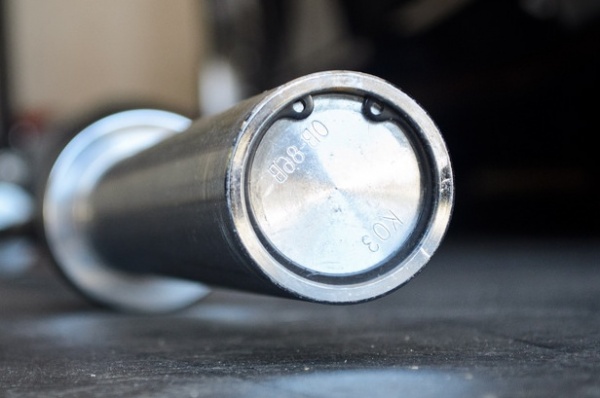
Medium to Soft Knurling
The knurling is the texture that cut into the shaft of the bar to help you grip it better. There’s a whole science to it and different steps involved.
How ever the maker decides to create the knurling pattern and texture, which we don’t need to go into here, the end result needs to be that you can get a good grip without the knurling damaging the palms of your hands over many reps.
No Center Knurling for High Rep Workouts
All bars have knurling over most of the length of the shaft. Some bars have a section of about six to nine inches of knurling in the center of the bar, while others are smooth in that area.
IWF competition rated bars are required to have center knurling as per the IWF spec that has been in place for decades, ever since the one-handed snatch was a competition lift and you needed to actually grip the center of the shaft.
While lifters doing other movements might like the center knurling, for the olympic lifts it serves no purpose anymore but to scratch the front of your neck during cleans. For this reason, lifters concentrating on olympic lifts prefer no center knurling.
910mm Spaced Ring Marks
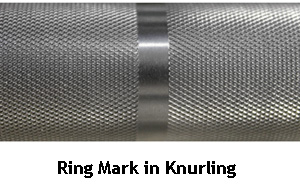
Every bar has a 1/4″ wide smooth mark in the knurling where you place your hands. IWF spaced markings are spaced for olympic weightlifting and are 910mm apart. Lifters grip in various spots depending on their body size, but the knurl marks at least provide a reference point to help them guide their hands into the right spot for them.
In recent years, many manufacturers have added IPF 810mm spaced marks as well, for a pair of “dual” marks 5cm away from each other. They just help you position your hands consistently. That’s all there is to it.
28mm Shaft Diameter
Not to be confused with the size of the sleeve where the weights go, which is always 49.8mm-50.0mm (1.97″) on a high quality bar.
Here we’re talking about the shaft that you grip. For the optimal grip, 28mm is the best size for men’s bars. It makes for a good pulling grip.
The diameter is also major factor in the amount of flex that the shaft has, which is very important for cleans. See the info further above on flex.
Sensitive and Smooth Rotation
How sensitively and easily the sleeves spin is very important for olympic lifts so you can transition between the pull and the catch without tweaking your wrists.
Manufacturers like Werksan have settled on 5 needle bearings per sleeve for their very best competition bars.
For budget WL bars you don’t need that many. Fewer bearings will reduce the spin, as will a combination of bushings and bearings, but it’s still good.
Bronze bushings are the next step down. Some WL bars we feature below have bronze bushings. Lubricated bronze slides well against steel (I think it has something to do with the dissimilar materials, such that bronze actually slides against steel better than steel-on-steel does).
Shaft Finish
The finish, or outer coating, applied to a bar makes a difference in its durability, tackiness, rust resistance, and how well it holds chalk.
Chrome
Chrome plating looks nice and wears well from repeated banging on a rack. All of the bars we sell, including our standard 1″ bars, and virtually all of the high quality bars sold today elsewhere, have a hard chrome finish rather than decorative chrome. The cracking and flaking chrome you might see on old bars might be decorative chrome. Hard chrome has the lowest level of corrosion resistance in any finishes, other than bare steel (ie: no finish). The smoothness of chrome makes it slippery when your hands get sweaty, even over good knurling. Chrome can sort of get a bad rep because most of the economy 300lb weight sets include a cheap chrome bar which might be made with decorative chrome. And the last thing about chrome is it does NOT hold chalk very well in comparison to all the other finishes.
Black Oxide
This is a thin coating that feels almost like bare steel. It’s thin enough that it doesn’t fill in any of the depth of the knurling like chrome or zinc plating does. It also gives a better grip than chrome. And it helps prevent rust (anti-corrosion), but the anti-corrosion properties of black oxide are activated by oil, so you have to oil it once in a while. It scratches more easily than other finishes, so a bar used in a rack will immediately show signs of use from the metal-on-metal contact. It can also wear off simply from the abrasion of your hands against it.
Black Zinc
Like black oxide, it provides a good grip and prevents corrosion without the need to oil it as much. Zinc plating has a certain thickness to it, so it does fill in the knurling slightly like chrome does, making the knurling a softer feel. Zinc itself is a bright silverish color and the black coating is actually applied over the bright zinc.
Stainless Steel
Basically this is the most expensive and the best, in my opinion. It looks like chrome, but it isn’t a chrome outer coating, it’s chromium mixed into the steel, which we call stainless steel. It is extremely resistant to corrosion and feels like a nice bare steel bar. The texture of the knurling doesn’t get filled in at all by any coating.
Weight
7ft olympic bars are made to weigh 45lb or 20kg / 44lb.
In this article we’re focusing only on the 20kg olympic bars. IWF weightlifting meets always use kilos, as do IPF powerlifting meets. Therefore the bars used for weightlifting tend to be calibrated to 20kg or pretty close to it.
The Bars
These 20kg olympic bars are in the affordable price range of approximately $300-400 and are suitable for beginner and intermediate lifters who don’t need a competition level bar.
Too pricey? Check out our Best Olympic Bar Under $200 article for some general-purpose bars that will work on a smaller budget.
Rogue 28mm Training Bar
| Shaft Diameter: | 28mm | Center Knurling: | No |
| Shaft Finish: | Black Zinc | Ring Marks: | IWF |
| Tensile Strength: | 190,000 PSI | Sleeve Surface: | Grooved |
| Sleeve Spin: | Bronze Bushing | Made In: | USA |
| Knurling Feel: | Medium | Weight: | 20kg |
Rogue’s 28mm Training Bar uses the same 190,000 PSI steel shaft as all their other men’s 7ft bars. That makes production a little easier!
Rogue stands behind their products, and you know they’ll be around for years to come. It’s one reason people often go for Rogue when in doubt.
Plus, Rogue makes their bars in their own facility in Columbus, OH. That makes it the only one on this page made in the USA.
It’s also the only bar here with bronze bushings. So this is questionable as a pure WL bar. Bronze bushings are only one step down from needle bearings, better than composite bushings as far as the sensitivity of the spin, if it’s constructed nice and tightly and lubricated right. If you’ve used a good bronze bushing bar and you’re ok with it as a WL bar, this could be a really good choice for you.
Price: $335 + Shipping
Bells of Steel Olympic Weightlifting Bar
| Shaft Diameter: | 28mm | Center Knurling: | No |
| Shaft Finish: | Chrome | Ring Marks: | Dual |
| Tensile Strength: | 240,000 PSI | Sleeve Surface: | Grooved |
| Sleeve Spin: | 8 Bearings | Made In: | China |
| Knurling Feel: | Medium | Weight: | 20kg |
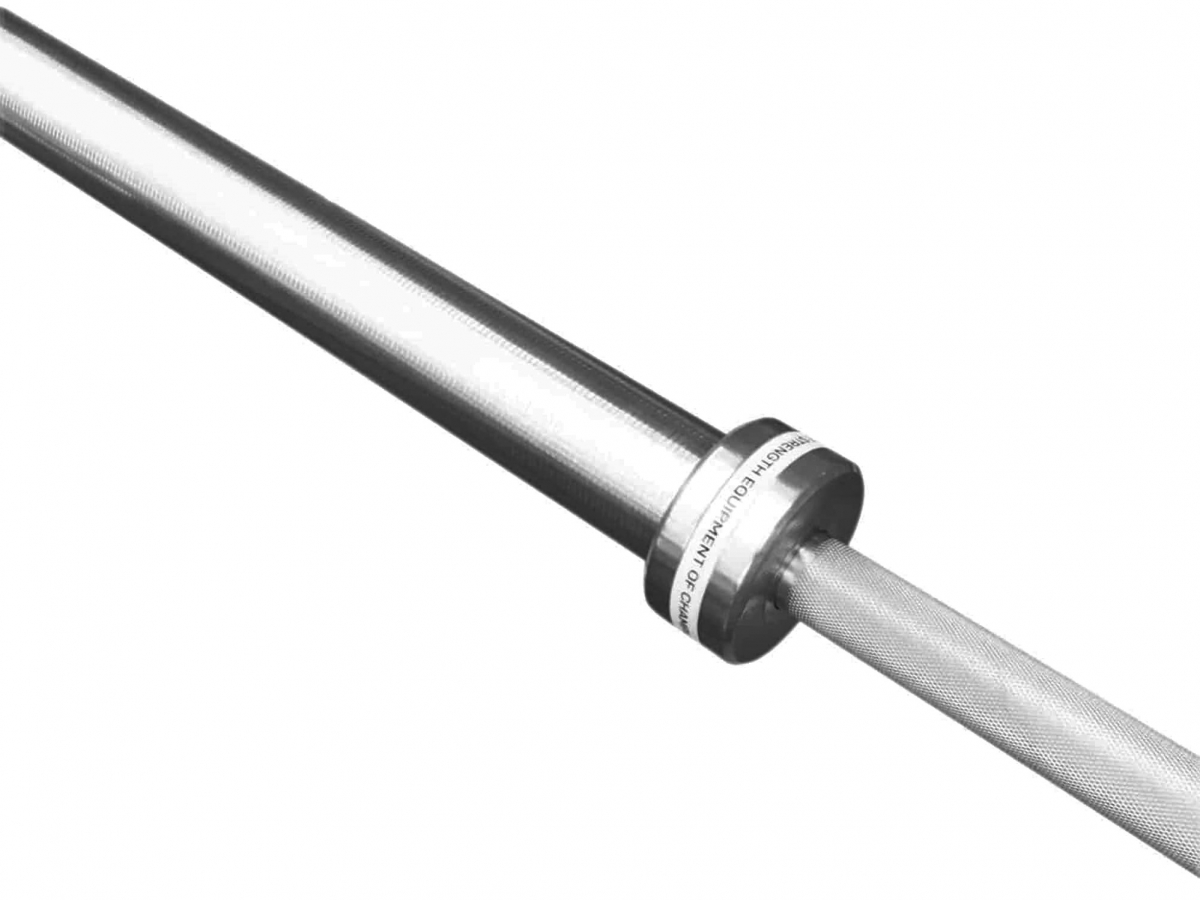
Impressively low price for a needle bearing bar with such a high tensile strength. BoS has good price points for some products like this. This 2.0 version uses better steel for the shaft and bearings.
The founder of BoS started the company in 2010 selling push sleds and kettlebells in Canada, and over the years they added a large selection of heavy-duty equipment and expanded to a US location in 2018. I’ve bought plates from them. Good experience.
Price: $275 & Free Shipping
York 32110 North American Training Bar
| Shaft Diameter: | 28mm | Center Knurling: | No |
| Shaft Finish: | Satin Chrome | Ring Marks: | Dual |
| Tensile Strength: | 170,000 PSI | Sleeve Surface: | Smooth |
| Sleeve Spin: | Bearings | Made In: | Canada |
| Knurling Feel: | Medium | Weight: | 20 kg |
York Barbell has been involved in olympic weightlifting since their inception in 1932. They revised their bars a year or so back without changing the model numbers. For this one they removed the center knurling, which they previously had on all their men’s 20 kg barbells, added dual ring marks, and I think they may have started using a higher tensile strength shaft… My memory is bad on that last one.
They call this a “North American” bar. Not quite USA made. “Made sort of here” is the general effect they were going for. I was able to dig up that it’s made in Canada.
From the close-up shot you see York’s patented split-sleeve design. Dead giveaway it’s a York bar when you see that.
Price: $419 + Shipping
Rep Fitness Gladiator MX Bar
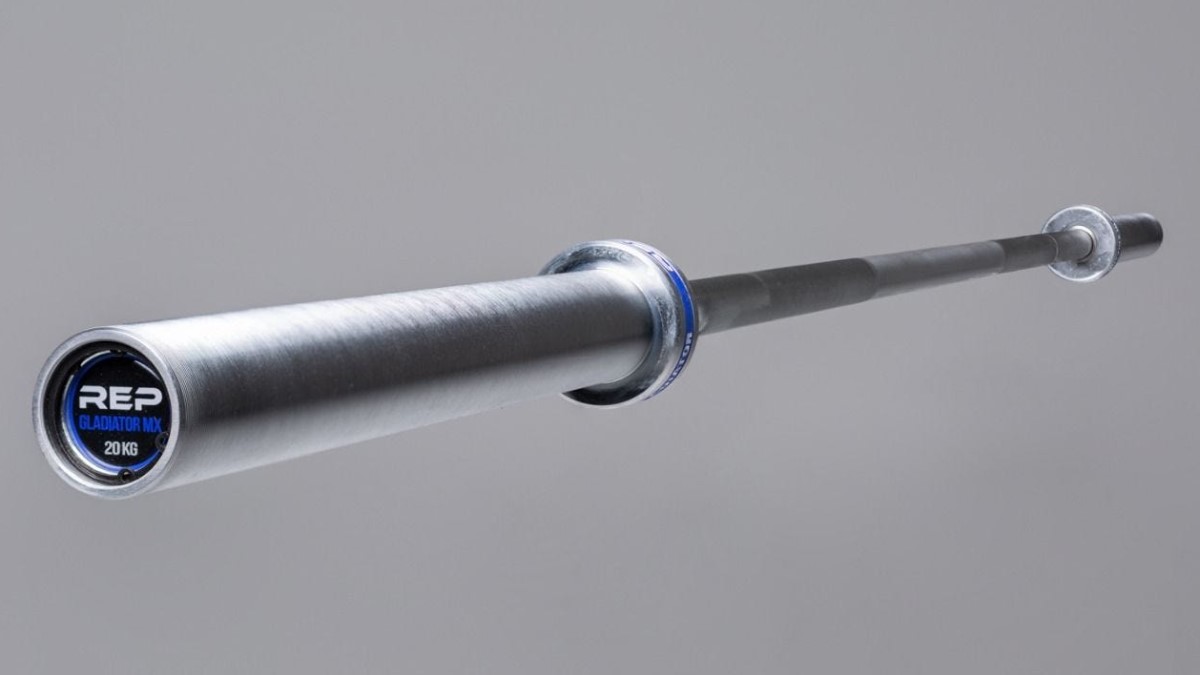
| Shaft Diameter: | 28mm | Center Knurling: | No |
| Shaft Finish: | Hard Chrome | Ring Marks: | IWF |
| Tensile Strength: | 190,000 PSI | Sleeve Surface: | Grooved |
| Sleeve Spin: | 5 Bearings | Made In: | China |
| Knurling Feel: | Medium | Weight: | 20 kg |
5 needle bearings per sleeve… That’s 1 more than Fringe!
Rep Fitness has been in business in Denver, Colorado (10 miles from Rage Fitness) since 2012, and they have earned the respect of the Crossfit crowd with their high quality equipment.
Rep has always had favorable reviews online and are good with answering questions. Rep’s equipment seems to be nearly as high quality as Rogue, but also mostly made in China.
Price: $470 & Free Shipping
FringeSport Bomba Bar V3
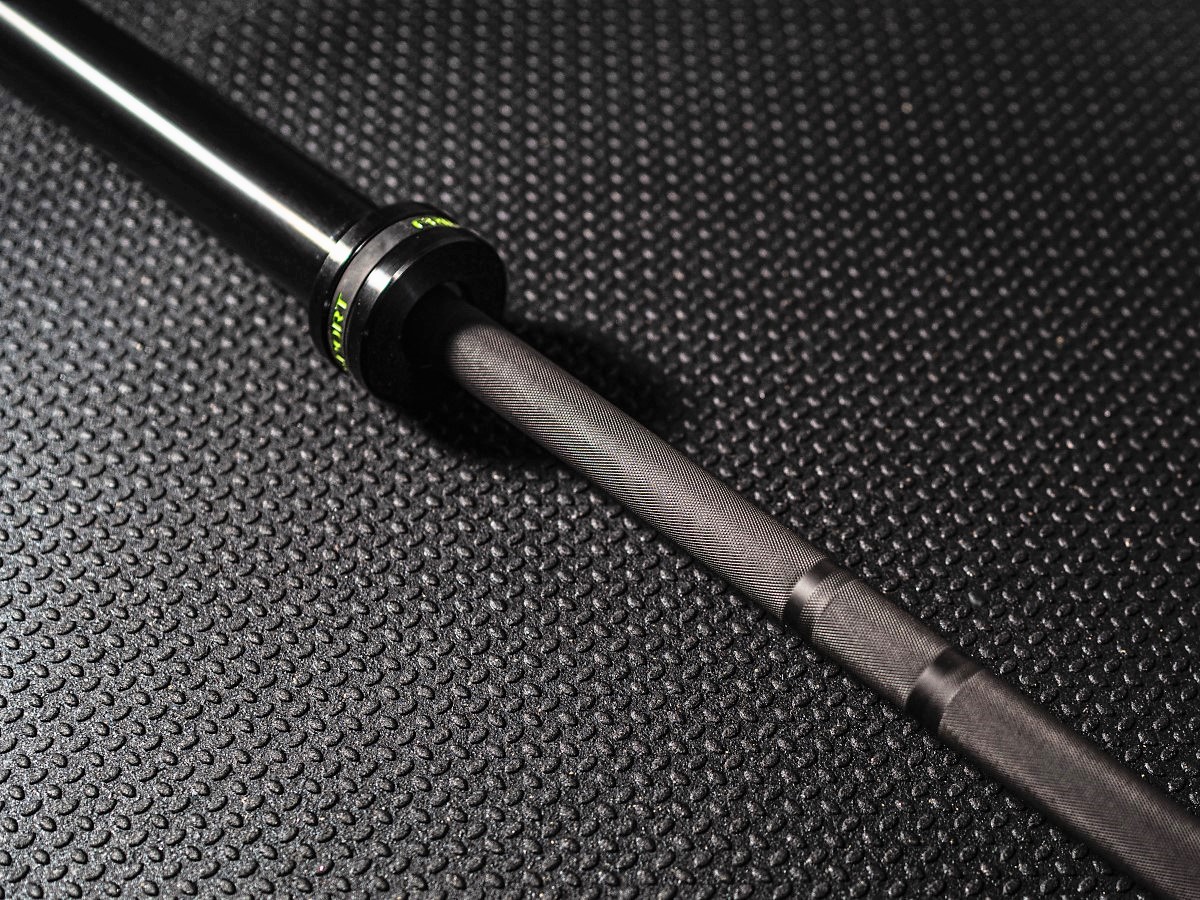
| Shaft Diameter: | 28mm | Center Knurling: | No |
| Shaft Finish: | Cerakote | Ring Marks: | Dual |
| Tensile Strength: | 201,000 PSI | Sleeve Surface: | Grooved |
| Sleeve Spin: | Bearings | Made In: | USA |
| Knurling Feel: | Medium | Weight: | 20 kg |
This is one of Fringe’s newest bars, and one of their only ones made in the USA.
As of now it’s the only bar we’re featuring in this article that has the sought-after Cerakote coating, the stuff that gun manufacturers and others use for its fantastic durability and its corrosion protection. Most importantly, it feels good too, not slick like chrome.
Fringe’s guarantee is the best in the industry. It’s more than just a warranty against defects. They offer a full 1-year guarantee. Return it for any reason within a year and get your money back! Or within 30 days they’ll even pay the return shipping.
Price: $399 & Free Shipping
Got any questions about these bars? Leave a comment and I’ll see if I can help!

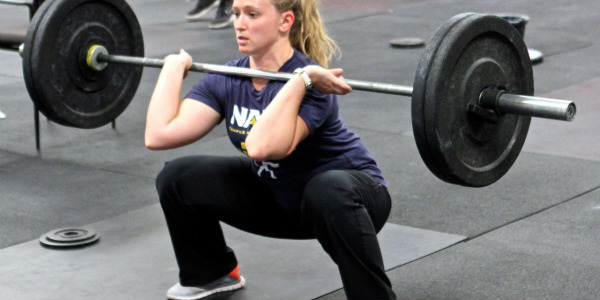

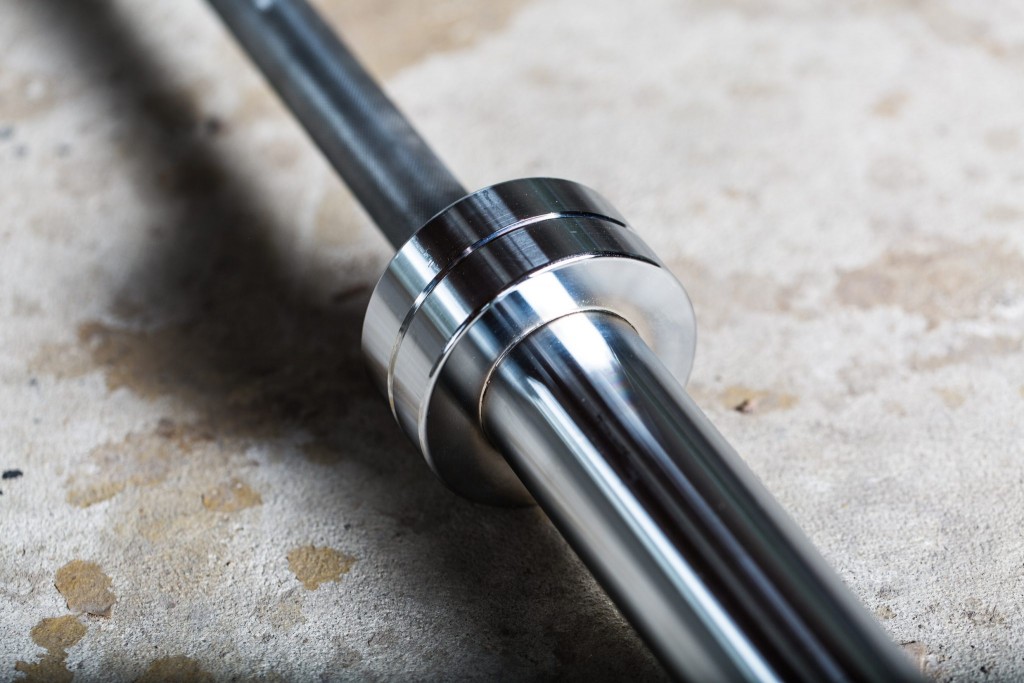
Which of these olympic barbells would you recommend above all others?
Get the Rep Gladiator! I think most people end up getting that one. Really well made stainless steel barbell.